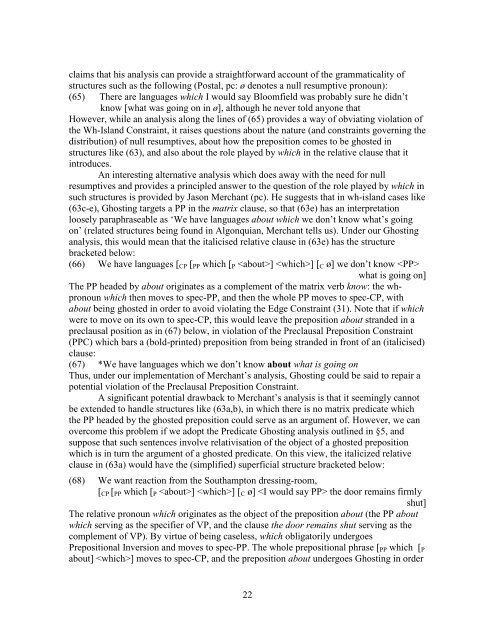1 GAPS, GHOSTS AND GAPLESS RELATIVES IN ... - ling.auf.net
1 GAPS, GHOSTS AND GAPLESS RELATIVES IN ... - ling.auf.net
1 GAPS, GHOSTS AND GAPLESS RELATIVES IN ... - ling.auf.net
You also want an ePaper? Increase the reach of your titles
YUMPU automatically turns print PDFs into web optimized ePapers that Google loves.
claims that his analysis can provide a straightforward account of the grammaticality of<br />
structures such as the following (Postal, pc: ø denotes a null resumptive pronoun):<br />
(65) There are languages which I would say Bloomfield was probably sure he didn’t<br />
know [what was going on in ø], although he never told anyone that<br />
However, while an analysis along the lines of (65) provides a way of obviating violation of<br />
the Wh-Island Constraint, it raises questions about the nature (and constraints governing the<br />
distribution) of null resumptives, about how the preposition comes to be ghosted in<br />
structures like (63), and also about the role played by which in the relative clause that it<br />
introduces.<br />
An interesting alternative analysis which does away with the need for null<br />
resumptives and provides a principled answer to the question of the role played by which in<br />
such structures is provided by Jason Merchant (pc). He suggests that in wh-island cases like<br />
(63c-e), Ghosting targets a PP in the matrix clause, so that (63e) has an interpretation<br />
loosely paraphraseable as ‘We have languages about which we don’t know what’s going<br />
on’ (related structures being found in Algonquian, Merchant tells us). Under our Ghosting<br />
analysis, this would mean that the italicised relative clause in (63e) has the structure<br />
bracketed below:<br />
(66) We have languages [CP [PP which [P ] ] [C ø] we don’t know <br />
what is going on]<br />
The PP headed by about originates as a complement of the matrix verb know: the whpronoun<br />
which then moves to spec-PP, and then the whole PP moves to spec-CP, with<br />
about being ghosted in order to avoid violating the Edge Constraint (31). Note that if which<br />
were to move on its own to spec-CP, this would leave the preposition about stranded in a<br />
preclausal position as in (67) below, in violation of the Preclausal Preposition Constraint<br />
(PPC) which bars a (bold-printed) preposition from being stranded in front of an (italicised)<br />
clause:<br />
(67) *We have languages which we don’t know about what is going on<br />
Thus, under our implementation of Merchant’s analysis, Ghosting could be said to repair a<br />
potential violation of the Preclausal Preposition Constraint.<br />
A significant potential drawback to Merchant’s analysis is that it seemingly cannot<br />
be extended to handle structures like (63a,b), in which there is no matrix predicate which<br />
the PP headed by the ghosted preposition could serve as an argument of. However, we can<br />
overcome this problem if we adopt the Predicate Ghosting analysis outlined in §5, and<br />
suppose that such sentences involve relativisation of the object of a ghosted preposition<br />
which is in turn the argument of a ghosted predicate. On this view, the italicized relative<br />
clause in (63a) would have the (simplified) superficial structure bracketed below:<br />
(68) We want reaction from the Southampton dressing-room,<br />
[CP [PP which [P ] ] [C ø] the door remains firmly<br />
shut]<br />
The relative pronoun which originates as the object of the preposition about (the PP about<br />
which serving as the specifier of VP, and the clause the door remains shut serving as the<br />
complement of VP). By virtue of being caseless, which obligatorily undergoes<br />
Prepositional Inversion and moves to spec-PP. The whole prepositional phrase [PP which [P<br />
about] ] moves to spec-CP, and the preposition about undergoes Ghosting in order<br />
22
















